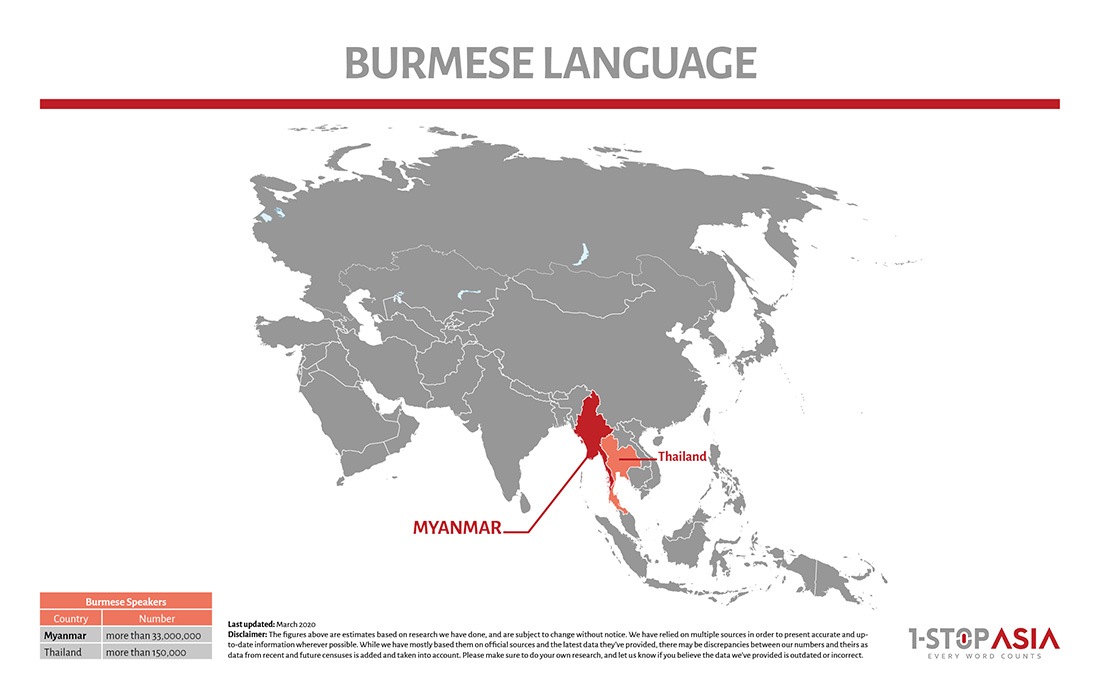Burmese Language
43M Burmese Speakers
The rounded appearance of letters in the beautiful Burmese script comes from the use of palm leaves as the traditional writing material.
If you feel it is time to improve your time-management and pay more attention to your clients
The complexity of Burmese translation
1. The written language > Translation Service
- Consonants: There are 33 consonants which use the Brahmic-style syllabic alphabet. Most likely it has been adapted from the Mon script in the 12th century CE. The original of Mon script was developed from a southern Indian script during the 8th century. The rounded appearance of the letters reflects their history that previously ancient Burma which used palm leaves as their traditional writing material. Straight lines would have torn the leaves. The Burmese name for the script is ca-lonh ’round script’.
- Grammar: The grammar structure is Subject-Object-Verb. The verb and its modifiers occupy a final position in a sentence, while all other elements are ordered somewhat freely before it. The writing direction is horizontal, from left to right. The fact that the structure is based on the syllabic alphabet means that each letter has an inherent vowel. Other vowel sounds are indicated by separate letters or diacritics which appear above, below, in front of, after or around the consonant.
- Verbs: Burmese verbs are not conjugated, therefore, they remain unchanged, regardless of the person, number, or tense. Most of the verbs consist of a root and separate particles that represent a mood, aspect, tense, positive/negative, and politeness.
2. The spoken language > Media Service
- Tones: Burmese is a tonal language with four main tones – high, low, creaky and stopped. Specially, The “creaky” tone is a high tone with a short vowel length ending in a glottal closure.
- Politeness: Various politeness markers play an extremely important role in the language. Their use depends on who is speaking to whom. The particle ပါ pa is frequently used after a verb to express politeness.
- The difference in writing and speaking: The formal written form, which mostly used in serious publications like newspapers and government papers, requires knowledge in an entirely different set of grammatical forms which is not similar in spoken Burmese.
Like Thai or Lao, Burmese requires no spaces between words, though spaces after each clause are used today to enhance readability. Translation technology traditionally revolves around the concept of spaces between words and that is why 1-StopAsia’s engineers and linguists have to work creatively to reap the same benefit from technologies for terminology control and translation memory.
Get exclusive insights into the world of translation, localization, and the language industry.
Our solution for you
Native translators with local knowledge
At 1-StopAsia, we have kept a close connection to quality Burmese translators, which are available to help you any time you have a Burmese translation. Our Project Managers will always be there to monitor your projects, minimize errors and make the delivery on time. As with other languages, we have incorporated an additional Quality Assurance team, which monitors the entire project and improves our process all the time. This well-structured work is aimed at enhancing our performance and delivering a satisfactory ultimate result.
25 years of experience
For over 2 decades working in the translation business, we’ve cultivated an in-depth understanding of the industry and most importantly we’ve built a flexible and efficient project management system. Our Project Managers are always there to handle your inquiries, save you time and deliver the translations within the allotted time for each assignment.

